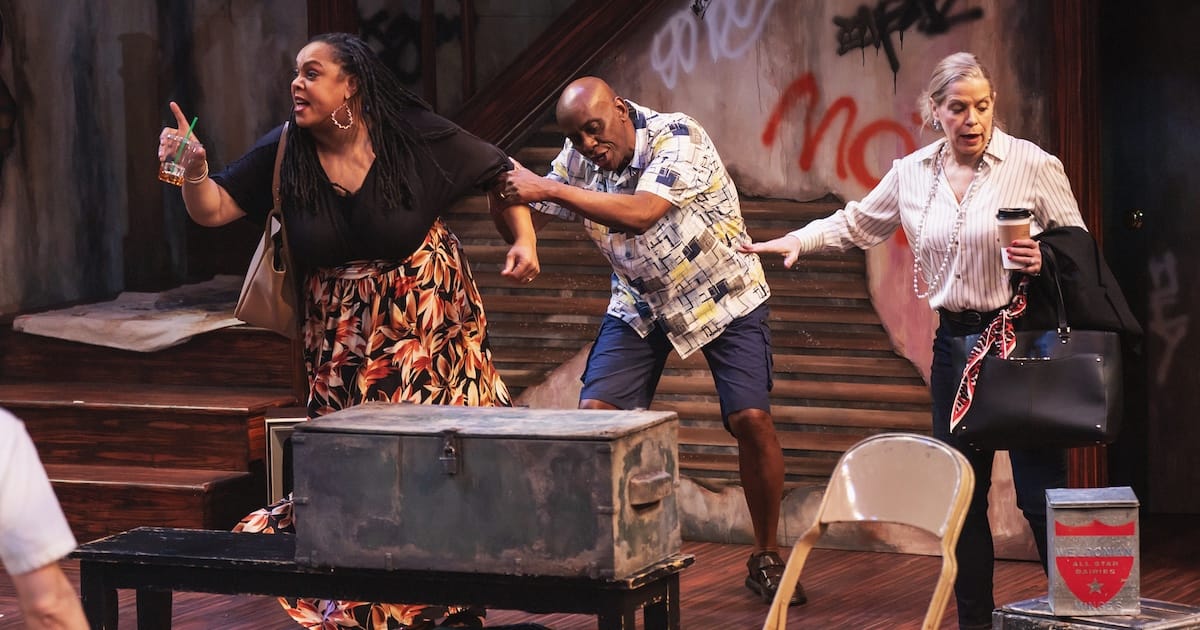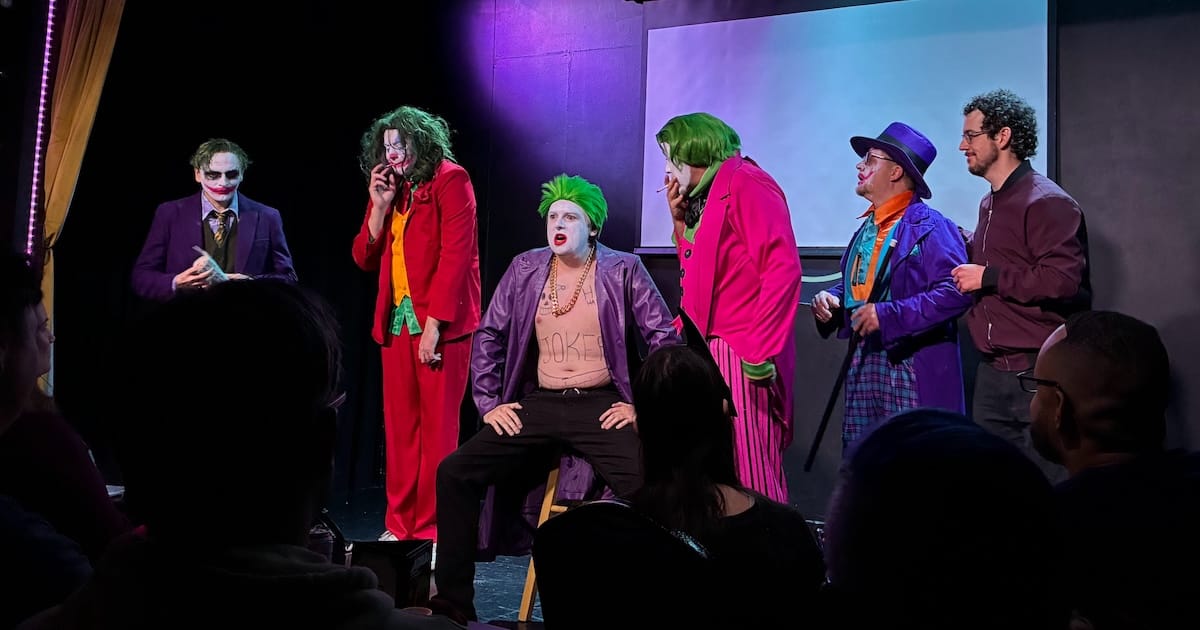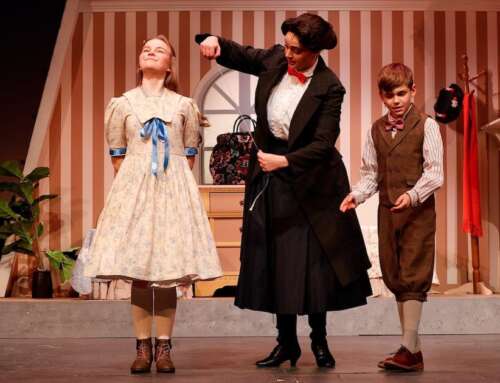Bruce Norris’ play tracking racism over the years is diluted by today’s environment
Bruce Norris’ Clybourne Park premiered in New York in 2011, winning both a Pulitzer Prize for Drama that year and then the Tony Award for Best Play. It went on to several first-rate regional productions — including the one I saw at the Seattle Repertory Theatre in 2012.
The show received rave reviews wherever it was performed, for good reason. It dealt honestly with the 20th century experience of racism in America, most specifically through the housing segregation that initially characterized many cities and, later, the destruction of African American communities through gentrification.
Clybourne Park opens in Act 1 in the same place and at the same moment as Lorraine Hainsberry’s masterpiece of 1959, A Raisin in the Sun. But Norris flips the focus from that of a Black family (unnamed and unseen here) wanting to purchase a house in a (fictitious) all-white Chicago neighborhood to that of the white family willing to make the sale. Norris retains one character from Raisin, the racist neighbor Karl. But now, having failed to dissuade the Black family from their offer, Karl turns his attention to the white sellers — Bev and Russ.
In an attempt to convince the couple to reject the Black family’s offer, Karl hurls his bigotry with abandon, even when Blacks (Bev and Russ’ housekeeper and her husband) are present. In a more nuanced performance (like the one I saw in Seattle) Damon Guerrasio’s Karl would be the personification of the middle-class Northern racists of the 1950s. But Guerrasio plays the role so broadly that Karl’s rants quickly become tiresome rather than deeply offensive to a contemporary audience. Besides — and this is one reason Clybourne Park now seems dated — today we regularly hear much worse and more explicit racism in our everyday lives.

Damon Guerrasio, left, and Don Randle in ‘Clybourne Park.’ | Photo: Amanda Tipton Photography
Racism under the radar
Bev and Russ (a convincing Kate Gleason and Brik Berkes) appear to be different from Karl. Unaware of the race of the couple who want their house, when they do find out the revelation is irrelevant. It soon becomes clear, however, that their prejudice is more subtle and unconscious than Karl’s but, one could argue, no less pernicious.
Bev, for instance, treats her Black housekeeper Francine (a dignified and gracious Ghandia Johnson) with a veneer of respect, but the true nature of their relationship surfaces when Bev tries to force Francine to accept a chafing dish that Bev won’t need in her new home. Francine gently continues to reject the gift, saying she has no more use for it than Bev, but that only provokes Bev to become ever more insistent. The more Bev pushes the more obvious it is to Francine, and us, that Bev would not treat her white friends the same way. This interaction seems drawn from a time when whites were often completely tone-deaf to their prejudice.
Although the narrative in Act 1 is easy to follow, it lacks punch and energy. This is partly due to the generally bland acting of the cast and Kenny Moten’s direction. But it’s also due to the fact that, in our current environment of unfettered, open racism, the dialogue seems tame and the characters a throwback to a time when hateful thoughts and feelings were largely disguised — at least in the North.
As a result, it was hard, for me at least, to muster much outrage at the situation being depicted or feel an emotional connection to the distressing human interactions taking place before us.

Kate Gleason, left, and Kendall Malkin in ‘Clybourne Park.’ | Photo: Amanda Tipton Photography
Fast-forward
Act II takes place 50 years later in the same house but with a completely different set of circumstances. In the intervening years, Clybourne Park has become a middle-class Black neighborhood interspersed with drug-infested crack houses. Now the new owners, a young white couple, want to turn it into a showplace in the rapidly gentrifying neighborhood. But they face a Black community fighting their plans to destroy the historic character of the house and, consequently, the community as a whole.
Like the limousine liberals of the ‘60s and ‘70s, this couple see themselves as enlightened. In their own minds, they’ve moved into what they believe is a post-racial world. The wife insists that “most of my friends are Black,” even though her husband points out that she can hardly name one — while he feels free to tell an offensive racial joke to the Black couple representing the Clybourne Park neighborhood. Again, these characters and their attitudes are drawn from a time long gone and, in a sense, more innocent than our own.
A much larger problem with Act II in this production is that the narrative is muddy. It’s not easy to comprehend precisely why the Black and white folks are meeting (something to do with city ordinances) and their interactions quickly deteriorate into a shouting match to see who has the thickest skin as racial comments and jokes hurtle back and forth.
Director Moten doesn’t seem to know what messages Norris wants to convey or how to convey the ones he has in mind. Moten maintains a one-note hysterical tone throughout the act and there is no subtlety or modulation to the accusations the various characters fling at each other.
For their part the cast members– the same ones as in Act I but in completely different roles – try to do their best, but Norris’ farcical treatment of his subject undermines the deadly serious story he apparently intends to tell. In the end the real star of this particular incarnation of Clybourne Park is Brian Mallgrave’s brilliant set, which magically transforms the ‘50s style home of Bev and Russ into a 2009 falling-down wreck of a place that cries out for a major renovation at the least.
Alice Kaderlan is a long-time dance and theatre critic and general arts writer. She has written for newspapers and online news sites in Seattle, Washington D.C., Pittsburgh and other cities for more than 40 years. She has also appeared on various public radio stations including WAMU-FM in D.C. and KUOW in Seattle and covered arts for NPR. She currently lives and writes in Denver.









Leave A Comment